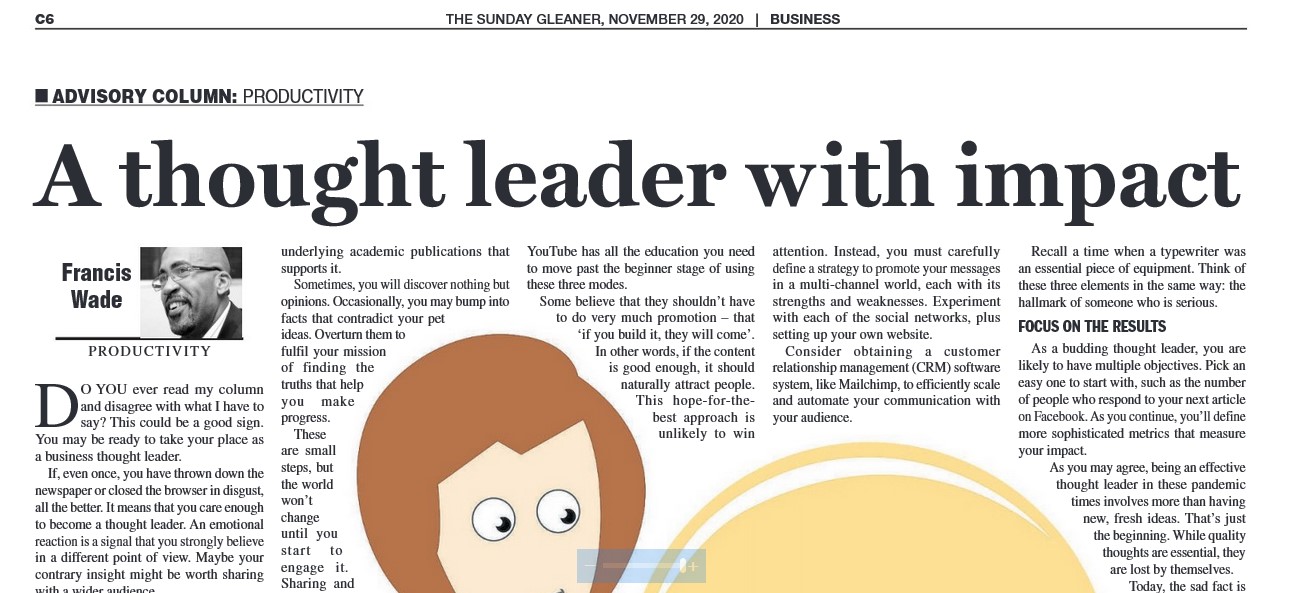On becoming a thought leader with impact
Do you ever read my column and disagree with what I have to say? This could be a good sign: you may be ready to take your place as a business thought leader.
If, even once, you have thrown down the newspaper or closed the browser in disgust, all the better. It means that you care enough to become a thought leader. An emotional reaction is a signal that you strongly believe in a different point of view. Maybe your contrary insight might be worth sharing with a wider audience.
If so, you need not be rich and famous to be the next Marcus Garvey, perhaps Jamaica’s foremost thought leader. Like he did, you can start with little more than a knowledge of how to use the latest technology. In his day, he established newspapers in several countries to share his content. By contrast, you could set up a free Facebook page in a few minutes.
However, that’s not likely to be enough. Garvey didn’t have a goal of being “an influencer” or being famous. His publications were the means to fulfill a much bigger vision. Take yourself to his level by following these steps.
1. Start Provoking
While you may not be prepared to write a book or give speeches to thousands, your smartphone affords you tremendous power to craft messages. What about finding an audience? Maybe they are just sitting in your social network waiting to hear what you have to say.
But what if you aren’t ready to formulate your initial thoughts into the written word, audio recordings or videos? One way to begin is to find and spread articles you agree or disagree with. Share, add your opinion and invite others to comment.
As you do so, consider this to be the start of your research and learning. Continue looking for quality evidence and the underlying academic publications that supports it.
Sometimes, you’ll discover nothing but opinions. Occasionally, you may bump into facts that contradict your pet ideas. Overturn them to fulfill your mission of finding the truths that help you make progress.
These are small steps, but the world won’t change until you start to engage it. Sharing and reacting to existing points of view brings your commitment out into the open, starting immediately.
2. Build Your Structure
Most people mistakenly believe that all you require to be a content creator is the right keyboard, audio recording device or video camera. While those are necessary elements, in today’s world they are simply insufficient to be effective.
Especially in these locked-down times, would-be thought leaders need a way to share their content, promote themselves to new audiences and manage their followers. The details of these three approaches are as follows.
– To deliver consistent messages you must specialize in a particular mode: text, audio or video. Why? It takes time to master a single one well enough to rise above the din and distractions your would-be followers face, even if you have world-class ideas. Fortunately, YouTube has all the education you need to move past the beginner stage of using these three modes.
– Some believe that they shouldn’t have to do very much promotion – “if you build it, they will come.” In other words, if the content is good enough, it should naturally attract people. This hope-for-the-best approach is unlikely to win attention. Instead, you must carefully define a strategy to promote your messages in a multi-channel world, each with its strengths and weaknesses. Experiment with each of the social networks, plus setting up your own website.
– Consider obtaining a Customer Relationship Management software system (like Mailchimp) to efficiently scale and automate your communication with your audience.
Recall a time when a typewriter was an essential piece of equipment. Think of these three elements in the same way: the hallmark of someone who is serious.
3. Focus on Results
As a budding thought leader you are likely to have multiple objectives. Pick an easy one to start with, such as the number of people who respond to your next article on Facebook. As you continue, you’ll define more sophisticated metrics that measure your impact.
As you may agree, being an effective thought leader in these pandemic times involves more than having new, fresh ideas. That’s just the beginning. While quality thoughts are essential, they are lost by themselves.
Today, the sad fact is that the smartest voice will not necessarily be heard above the distractions. Think of your “message delivery” skills as a critical partner to your creativity and you’ll start to confront the gaps in becoming a business thought leader with impact.

